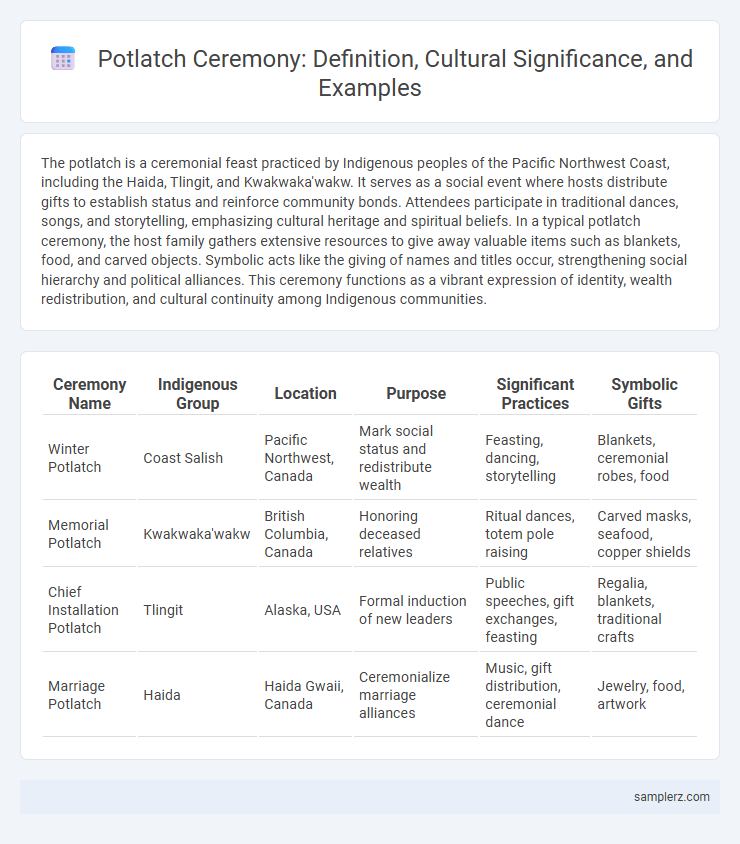The potlatch is a ceremonial feast practiced by Indigenous peoples of the Pacific Northwest Coast, including the Haida, Tlingit, and Kwakwaka'wakw. It serves as a social event where hosts distribute gifts to establish status and reinforce community bonds. Attendees participate in traditional dances, songs, and storytelling, emphasizing cultural heritage and spiritual beliefs. In a typical potlatch ceremony, the host family gathers extensive resources to give away valuable items such as blankets, food, and carved objects. Symbolic acts like the giving of names and titles occur, strengthening social hierarchy and political alliances. This ceremony functions as a vibrant expression of identity, wealth redistribution, and cultural continuity among Indigenous communities.
Table of Comparison
| Ceremony Name | Indigenous Group | Location | Purpose | Significant Practices | Symbolic Gifts |
|---|---|---|---|---|---|
| Winter Potlatch | Coast Salish | Pacific Northwest, Canada | Mark social status and redistribute wealth | Feasting, dancing, storytelling | Blankets, ceremonial robes, food |
| Memorial Potlatch | Kwakwaka'wakw | British Columbia, Canada | Honoring deceased relatives | Ritual dances, totem pole raising | Carved masks, seafood, copper shields |
| Chief Installation Potlatch | Tlingit | Alaska, USA | Formal induction of new leaders | Public speeches, gift exchanges, feasting | Regalia, blankets, traditional crafts |
| Marriage Potlatch | Haida | Haida Gwaii, Canada | Ceremonialize marriage alliances | Music, gift distribution, ceremonial dance | Jewelry, food, artwork |
Historical Origins of Potlatch Ceremonies
Potlatch ceremonies originated among Indigenous peoples of the Pacific Northwest Coast, including the Kwakwaka'wakw, Tlingit, and Haida tribes, serving as a vital social institution for wealth distribution and status affirmation. Historically, these events featured elaborate feasts and gift-giving rituals that reinforced clan alliances and spiritual connections. Archaeological evidence and oral histories trace potlatch practices back over a thousand years, emphasizing their role in preserving cultural identity and community cohesion.
Key Elements of a Traditional Potlatch
A traditional potlatch ceremony features key elements such as the elaborate distribution of gifts, which symbolizes wealth redistribution and social status within Indigenous Pacific Northwest communities. Feasting plays a central role, serving as a communal gathering that reinforces social bonds and honors ancestors. Ceremonial dances and speeches accompany the event, preserving oral histories and cultural identity through storytelling and ritual performance.
Cultural Significance of Potlatch Rituals
Potlatch rituals hold profound cultural significance among Indigenous communities of the Pacific Northwest, serving as vital ceremonies for social status affirmation, wealth redistribution, and community bonding. These events encompass elaborate gift-giving, dance, and storytelling that reinforce tribal history and kinship ties. Through potlatch, leaders legitimize authority and ensure cultural continuity by honoring ancestors and communal values.
Ceremonial Gift-Giving Practices
Potlatch ceremonies exemplify complex ceremonial gift-giving practices, where hosts distribute valuable items such as blankets, copper shields, and food to affirm social status and redistribute wealth within Indigenous Pacific Northwest cultures. These exchanges reinforce community bonds, social hierarchy, and cultural identity through highly ritualized acts of generosity and reciprocity. The potlatch's emphasis on public gifting underscores its role as a significant social institution beyond mere economic transactions.
Potlatch as a Form of Social Status Display
Potlatch ceremonies serve as a powerful social status display among Indigenous communities of the Pacific Northwest, where hosts publicly distribute wealth and gifts to assert rank and prestige. These elaborate feasts reinforce social hierarchies through the size and generosity of the gift-giving, showcasing the host's economic power and lineage. The cultural significance of potlatch extends beyond mere celebration, functioning as a strategic display of influence and social capital.
Role of Potlatch in Community Cohesion
Potlatch ceremonies serve as essential social events that reinforce community cohesion among Indigenous peoples of the Pacific Northwest Coast. By redistributing wealth and hosting communal feasts, these ceremonies strengthen alliances, affirm social status, and ensure the transmission of cultural knowledge across generations. The role of potlatch cultivates collective identity, mutual support, and the continuity of traditions vital to community stability.
Examples of Potlatch Among Pacific Northwest Tribes
Potlatch ceremonies among Pacific Northwest tribes, such as the Kwakwaka'wakw and Tlingit, showcase elaborate gift-giving, feasting, and symbolic dances that assert social status and redistribute wealth. In these events, hosts present valuable items like cedar bark, woven blankets, and intricately carved masks to honor ancestors and reinforce community bonds. The potlatch serves as a vital cultural institution preserving Indigenous traditions, social hierarchy, and spiritual beliefs within coastal First Nations.
Notable Potlatch Ceremonies in History
The Kwakwaka'wakw people of the Pacific Northwest are renowned for their elaborate potlatch ceremonies, which involve gift-giving, feasting, and the reaffirmation of social status and heritage. One of the most notable historical potlatch ceremonies occurred in 1921 when Chief George Hunt hosted a grand event that preserved indigenous cultural practices during a period of government suppression. These potlatches serve as vital cultural expressions that reinforce community bonds, redistribute wealth, and celebrate ancestral lineage.
Potlatch and its Legal Challenges
The potlatch, a traditional Indigenous ceremony of the Pacific Northwest, involves elaborate feasting, gift-giving, and social status reaffirmation, reflecting deep cultural significance. Colonial governments imposed legal bans on potlatches in the late 19th and early 20th centuries, aiming to suppress Indigenous cultural practices and assimilate Native peoples. Despite these legal challenges, potlatches have experienced revival, serving as powerful symbols of cultural resilience and Indigenous identity restoration.
Modern Revivals and Adaptations of Potlatch
Modern revivals of the potlatch ceremony emphasize cultural preservation and community resilience among Indigenous peoples of the Pacific Northwest Coast. Contemporary adaptations incorporate both traditional gift exchanges and multimedia presentations to engage younger generations and global audiences. These ceremonies often serve as platforms for asserting Indigenous rights and celebrating cultural identity in urban and rural settings.

example of potlatch in ceremony Infographic
 samplerz.com
samplerz.com